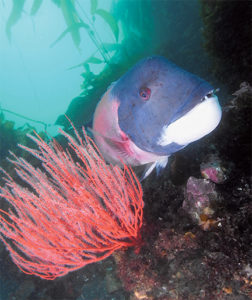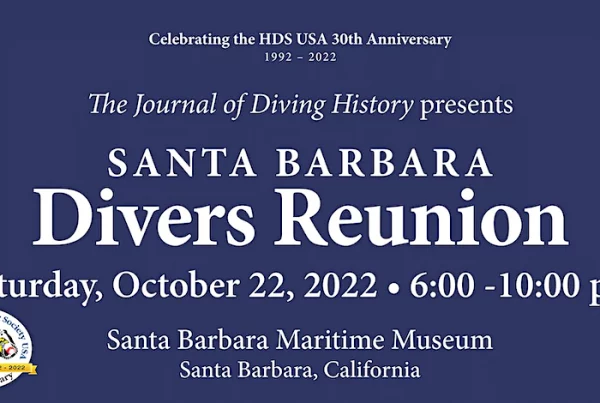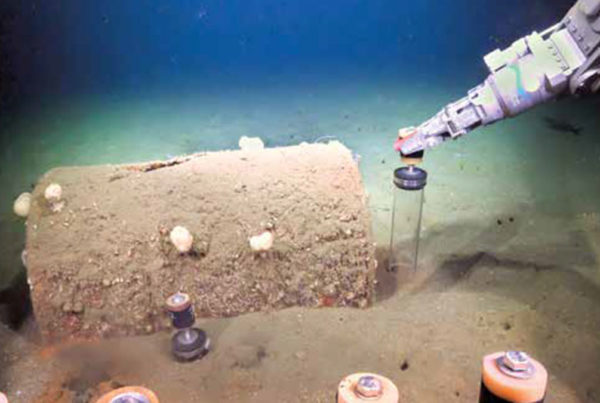 AT-A-GLANCE
AT-A-GLANCE
Location: On the mainland side Anacapa Island (actually a chain of three islets) that is the closest to mainland of all the Channel Islands at only 11 miles off Port Hueneme. It is wedged between the dive sites known as the Pelican Preserve (which can only be dived in November and December) and Goldfish Bowl.
Access: Boat only.
Skill: All levels.
Visibility: Fair to good.
Depths: up to 50 feet on sand.
Hunting: Not allowed.
Photography: Excellent fish photography. Only fair for all other.
Notable hazards: Strong currents.
After the dive charter boat Raptor had anchored up the skipper and divemaster gathered the divers on deck and explained that the dive site had no name but that they had metered the bottom and it showed an interesting profile of rocky ridges. Since the site had no official name, he proposed an informal contest of sorts to name the location. So I went off with that goal in mind. And I came across a pleasant surprise: lingcod.
Descending to the bottom where the reefs meet the sand at about 45 feet I was immediately greeted by a lingcod. But he (or she) did not stick around long and quickly swam off. I gave pursuit but immediately lost the creature in a blizzard of fish. Ahh, this I could tell was going to be a good dive — a fishy dive.
I enjoyed my excursion cruising up and down the predicted rocky ridges. It was an excellent location for my goal of macro photography. I love the challenge of photographing fish. First I set my sights on the many blacksmith fish that were schooling unusually close. Constantly on the move, it is quite hard to pick out an individual animal. A few mediocre shots later, I gave up and moved on.
Attached to the rocks were small gardens of colorful gorgonian in the variety of red, golden and purple, one of my favorites. They are not especially large fans but their color makes for great photos, especially when you can get a small reef fish to pose in front or on top their spread. While purple gorgonian are not unusual at Anacapa and west end of Santa Cruz Island they seem to be especially plentiful on the mainland side of the west end of Anacapa where they form large clusters. I was in the photo zone zeroing in on the large number of ghost gobies (also known as black eyed gobies) that were scattered here and there across the reef and sand. I was hoping to catch one perched on a branch of purple gorgonian. Snap, mission accomplished.
Nearby, I found another lingcod. I know it was not the same one as my greeter because of its willing to sit still for portraits and one guy was bigger, although still not particularly large. Lingcod are highly desired by sport and spearfishers. Its flesh is an odd bluish-green color, but it changes to a creamy white when cooked. This area of Anacapa is, however, a marine preserve, as is most of the mainland side of Anacapa Island. It is nice to see several of these fish that have been heavily hunted.
Additional fishy encounters included a large yellow and black striped treefish with rich red lips. There was also numerous unusually placid large calico bass. A big male sheephead gave me a lot of fun. There were black perch, opaleye and painted greenling that also provided photo opportunities.
Spotting photogenic fish was easy here as there was little to no kelp, unusual considering the excellent bottom topography. Also odd was the curious lack of nudibranchs, one of my favorite invertebrates to photograph. There were lobsters but only a few shy guys and on the sand there was not much to see.
Heading back to the reef as my dive drew to a close I came across yet another even larger lingcod, this one perched perfectly on a ledge protrusion of the reef. Lingcod need to be approached slowly as they do spook easily. Get low and shoot up. While they always have fascinating faces try to catch them in a in a low angle as they open their mouths in the rhythmic motion of inhaling water to pass it over their gills. They have mouths full of sharp teeth and this is the most interesting way of photographing them. If you get a particularly cooperative subject, which most are if you are non-threatening, you can take a number of different angles for the best shot. Be aware that sometimes they may be nesting on eggs. Look for this and try not to scare them off as this will leave the nest open to predators.
As I hung out at my safety stop I contemplated my name entry into the contest for the dive site. Lingcod Lair. Sounds good to me. I shared it on deck but nothing was said. It was a winner in my mind so here it is.
Special thanks to the dive charter boat Raptor for assistance in creating this article.









